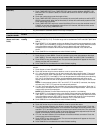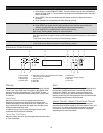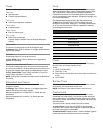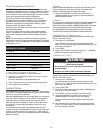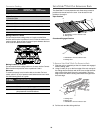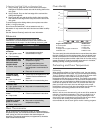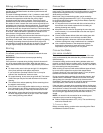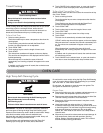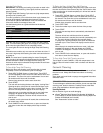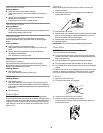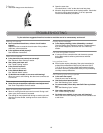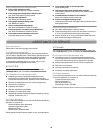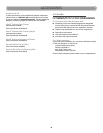
12
Baking and Roasting
IMPORTANT: The convection fan and convection element may
operate during the Bake function to enhance performance and
heat distribution.
The oven will take approximately 12 to 17 minutes to reach 350°F
with all oven racks inside the oven cavity. The preheat cycle rapidly
increases the temperature inside the oven cavity. Higher
temperatures will take longer to preheat. Factors that impact
preheat times include room temperature, oven temperature, and
the number of racks. Unused oven racks can be removed prior to
preheating your oven to help reduce preheat time. The actual oven
temperature will go above the set temperature to offset the heat
lost when the oven door is opened to insert food. This ensures that
the oven will begin at the proper temperature when you place food
in the oven. Insert food when the preheat tone sounds. Do not
open the door during preheat until the tone sounds.
During baking or roasting, the bake and broil elements will cycle on
and off in intervals to maintain the oven temperature.
Depending on the model, if the oven door is opened during baking
or roasting, the heating elements (bake and broil) will turn off
approximately 30 seconds after the door is opened. They will turn
on again approximately 30 seconds after the door is closed.
Broiling
Broiling uses direct radiant heat to cook food.
The element cycles on and off in intervals to maintain the oven
temperature.
IMPORTANT: Close the door to ensure proper broiling
temperature.
If the oven door is opened during broiling, the broil element will
turn off in approximately 30 seconds. When the oven door is
closed, the element will come back on approximately 30 seconds
later.
■ For best results, use a broiler pan and grid. It is designed to
drain juices and help avoid spatter and smoke.
If you would like to purchase a Broiler Pan Kit, it may be
ordered. See “Accessories” section to order.
■ For proper draining, do not cover the grid with foil. The bottom
of the broiler pan may be lined with aluminum foil for easier
cleaning.
■ Trim excess fat to reduce spattering. Slit the remaining fat on
the edges to avoid curling.
■ Pull out oven rack to stop position before turning or removing
food. Use tongs to turn food to avoid the loss of juices. Very
thin cuts of fish, poultry or meat may not need to be turned.
■ After broiling, remove the pan from the oven when removing
the food. Drippings will bake on the pan if left in the heated
oven, making cleaning more difficult.
Convection
In a convection oven, the fan-circulated hot air distributes heat
more evenly. This movement of hot air helps maintain a consistent
temperature throughout the oven, cooking foods more evenly,
while sealing in moisture.
Most foods, using convect baking mode, can be cooked by
lowering cooking temperatures 25°F (14°C). The cooking time, can
be shortened significantly when using Convect Roast, especially
for large turkeys and roasts.
■ It is important not to cover foods with lids or aluminum foil so
that surface areas remain exposed to the circulating air,
allowing browning and crisping.
■ Keep heat loss to a minimum by opening the oven door only
when necessary. It is recommended to use the oven light to
monitor progress.
■ Choose cookie sheets without sides and roasting pans with
lower sides to allow air to move freely around the food.
■ Test baked goods for doneness a few minutes before the
minimum cooking time using a method such as a toothpick.
■ Use a meat thermometer or the temperature probe to
determine the doneness of meats and poultry. Check the
temperature of pork and poultry in 2 or 3 places.
Convection Bake
(on some models)
The convection element is hidden in the rear panel of the oven
cavity, and assisted by the convection fan, provides balanced,
efficient heating.
Convection baking can be used for baking delicate cakes and
pastries, as well as foods on multiple racks. It is helpful to stagger
items on the racks to allow a more even flow of heat. If the oven is
full, extra cooking time may be needed.
When cooking an oven meal with several different types of foods,
be sure to select recipes that require similar temperatures.
Cookware should sit in the oven with at least 2" (5 cm) of space
between the cookware and the sides of the oven.
During convection baking preheat, the convection element, broil
element and the CleanBake™ element all heat the oven cavity.
After preheat, the convection element, broil element and the
CleanBake™ element will cycle on and off in intervals to maintain
oven temperature, while the fan circulates the hot air.
If the oven door is opened during convection baking, the fan turns
off immediately when the door is opened and turns on immediately
when the door is closed. Convection, Bake and Broil elements will
turn off approximately 30 seconds after the door is opened. They
will turn on again approximately 30 seconds after the door is
closed.
NOTE: it is normal for the convection fan to run during non-
convection cycles as well as during preheat.
■ Reduce recipe temperature 25°F (14°C). The cook time may
need to be reduced also.
To Convection Bake:
Before convection baking, position racks according to the “Rack
and Bakeware Positions” section.




